#game medium
Text
The Game Medium: Tension Between Game and Narrative
(SPOILERS FOR THE GAME OMORI)
Heya guys. I’m thinking about making some blog posts that focus on game design and game narrative. These can just be leftover thoughts on a game or just observations that can be applied to the game medium or game genres. I don’t think I’ll do these routinely. These will just come up whenever I feel like it.
If you look at it a certain way, it might be a bit weird to call video games a narrative medium. It’s one of the few narrative mediums in which the medium doesn’t need a story to be truly engaging; the story can literally just be a 2 second premise that justifies the fun stuff you do the entire game like in Mario or it can have none at all like Pac-Man. In other words, the “fun”, the main source of engagement, can be completely disconnected from the in-text narrative.
When you step forth into game design school, one of the first things you’ll probably learn is the M/D/A paradigm: mechanics, dynamics and aesthetics. The mechanics of a game, the individual actions and abilities that you’re allowed to do (jump abilities), will inevitably dictate dynamics, the strategies a player can come up with (the sequence of jump abilities to make across a gap). These dynamics will eventually reinforce the overall aesthetic of the game, the art style, tone, and narrative. In a truly narratively cohesive game, how you feel when doing the dynamic should reinforce what the character feels in the story. However, this dynamic-aesthetic connection usually doesn’t focus on narrative as often as you think it does. In many cases when strategies connect to aesthetics, it’s usually that dynamics reinforce a power fantasy: the ability to be a superhero, a knight, the fastest thing alive, etc. As long as the power fantasy is reinforced through these mechanics and dynamics, you don’t really need a story to reinforce it even further because the mechanics and dynamics are already doing that. It’s entirely optional to have a competently written story for a game.
Because mechanics-dynamics are usually the core of what makes a game engaging, there can be this grave disconnect between what makes a game engaging and what makes the story engaging. This is why many games in earlier ages never really bothered with a story, because all you really need to make a good game is good mechanics and dynamics. This is also why, even in modern games, ludonarrative dissonance is a pretty severe issue, because the interactive engagement powered by mechanics-dynamics won’t be congruent with the engagement powered by narrative. This is how you get Bioshock Infinite where you spend the entire game driving hooks into skulls and gunning down masses of people while the narrative tries to wax poetry about violence and why it sucks.
Compared to other mediums, having different types of engagement is nothing new. A moviegoer can watch a movie just for the movie just for the spectacle, an anime fan can watch an anime just for fight scenes, and a reader can read erotica just to masturbate, but very few mediums allow such a massive disconnect between the narrative and the other types of engagement. The only type of medium I can think of is pop music. Tell me if you heard this before for a pop song: “the lyrics are kinda nonsensical (Rather Be by Clean Bandit) or awful (Sorry by Justin Bieber), but it’s such a bop!” Both songs referenced have reached the top 100 in the billboard charts in previous years. So if interactive engagement can be separated from narrative engagement, how do we handle that?
The easiest answer to this is to make the focus of interactive engagement and the focus of narrative engagement completely congruent to each other. This means making where the feelings of fun of the game happen when strong narrative and thematic beats occur, and having the emotions match accordingly. Boss battles tend to be great examples of this. At the end of a boss battle, how do I feel when doing my mechanics and strategies against them. Did the boss put in an extremely close duel and I feel honored for being able to beat them with my inventive strategies? Or did the boss just, in their final phase, sit there, waiting for me to kill them. These 2 bosses require different dynamics to defeat them, leading to different emotions, and, thus, requiring different story beats to them to match that emotion, to be congruent with the mechanics-dynamics used. However, what happens if the focus of interactive engagement intentionally causes tension with that of the narrative engagement?
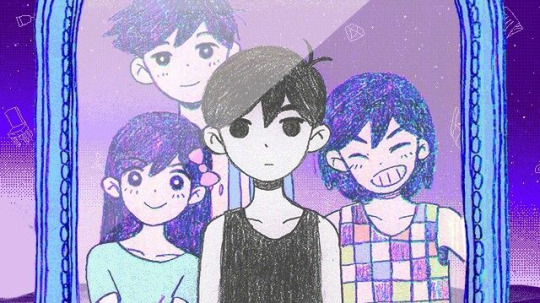
OMORI: “The Cruelty of Fun” (SPOILERS FOR OMORI)
To summarize the game, OMORI centers around a kid named Sunny who, after 4 years, decided to become a shut-in after the death of his sister Mari. Ever since then, Sunny has been living within his dreamscape to escape from the real world and from truly processing his sister’s death. Meanwhile, Sunny’s perfect friend group back then completely broke up after the loss of Mari: Hero heads off to College, Aubrey turned into an angry delinquent, and Kel decided to focus more on other friends and high school sports. It’s not until Sunny’s family decide to move out of town did Kel finally reach out to Sunny, inviting him to hang out one last time before moving out.
From then on, the game takes place in 2 completely different worlds: Sunny’s dreamscape that he uses as escapism and the real world in Faraway Town. While both worlds use the same battle system, they differ from each other in certain mechanics, leading to completely different dynamics. The biggest mechanic of the entire game is the emotion mechanic in which each battle unit can hold a certain emotion, and, like most rock-paper-scissors type mechanics, the emotions force a unit to be strong against 1 emotion and weak to another. Happy beats angry, angry beats sad, and sad beats happy. What makes the system so interesting is that, unlike Pokemon or other RPGS, these emotions can be changed dynamically during battle. As such, many of the key dynamics of the game involve manipulating emotions to get the perfect setup and maximum amounts of damage.
Furthermore, another key mechanic of the game is the follow up system in which one of your party members can do a follow up action after doing a basic attack. These follow up actions can lead to massive changes such as changing the mood of a party member or allowing another party member to attack again. Mastering these follow up attacks will allow players the ability to do quick reversals and react to sudden changes. Both the follow up mechanic and the emotion manipulation mechanic are tested immensely in the minor battles and the boss battles, and, in my opinion, are the components that make the battles of Omori engaging.
Both of these key mechanics are only present in the dreamscape world, not in the real world. Because of that, the dynamics and strategies of the real world contrast heavily from that of the dreamscape. When you exit the house as Sunny, battle encounters are little more than a game of clicking the damage action or heal up any damage you receive, and then repeat until the enemy dies. The dynamics of emotion manipulation and the collaboration of emotion manipulation are simply not present, leading to battles in the real world feeling incredibly drab. In fact, if you didn’t get certain items, battles might feel impossible and hopeless as you just flail your arms at the enemy and waste away all your bandages to fix all of the damage.
Youtuber ABItorial made a fantastic video exploring this in which he investigated the dynamic contrast and explained how it affects the emotions of the player and how that emotion gets shaped by the context of the story. In the sense of Omori, it shows the alluring nature of escapism, to hide away in a room and believe in a dreamworld where you have all of the power, especially when in the real world, you just feel so helpless. ABI described it as the “cruelty of fun” in which, by imagining a world in which nothing is wrong and “everything is okay” by the game’s own text, your real friends suffer outside.
This cruelty is shaped by the contrast between what’s interactively engaging (by the mechanics-dynamics) and what’s narratively engaging. In terms of narrative engagement, the fun lies in the dreamscape where one can do interesting strategies in battle and have access to a variety of abilities. Meanwhile, all of the more three-dimensional characters and the tension of the plot lies in the real world. All of the characters in the dreamscape are two-dimension, or at least, flatter than their real world counterparts. The main consequences and conflict caused by Mari’s death exist in the real world while, in the dreamscape, the death is not even mentioned.
As such, there’s this tension between what the player wants to do in terms of a game and what the player wants to do in terms of the story, selling this feeling of what escapism is so alluring to some people. It sells what Sunny is feeling in Omori expertly and doing it in a way that only a game can, because games are one of the few mediums that can allow for a clean separation between game and story. Writers and video game designers, more than most narrative mediums, have to work harder to make those elements congruent with each other.
For the sake of argument, say that someone wanted to adapt Omori into a TV show or a movie: how would one make the dreamscape, with its two-dimensional characters and saccharine “friendship solves all” morals, as interesting or engaging as the game does through its mechanics and dynamics which, in game, symbolizes the amount of power, safety, and control Sunny has in his own world. One would have to make massive changes to sell that someone would want to stay in the dreamscape when literally a friend outside the dream world turns into a bully and another contemplates suicide. In a movie context, if you just do a direct copy and paste translation, Sunny would come off as selfish and cowardly, hiding behind a flimsy facade and refusing to help his own friends. Without a powerful interactive contrast causing tension between the narrative engagement, something has to replace it.
I highlight this aspect of Omori because this is a very unique aspect to games as a narrative medium and I feel, for more interactive and engaging stories, designers and game writers should explore it. Omori is not the only game that does this. Undertale’s genocide run heavily contrasts the interactive desire of being a completionist with being a murderer, something made explicit with Flowey’s motivation and Chara’s quote of “perverted sentimentality”. Another example of this is Lewis’s story from What Remains of Edith Finch in which the player is asked to play 2 games simultaneously: one where you play as an adventurer in your dreams and the other where you repetitively chop fish heads in your monotonous job.
The further we can explore these different aspects of the game medium, the more we can utilize the medium to its fullest. If you have any other games or game scenes that utilize this type of tension, please let me know! I’m curious.
2 notes
·
View notes
Text
okay fun silly question because these are my favorite types of stories but what are your guys' favorite pieces of media that require the audience to go in blind? usually the synopsis is a diversion of some sort or there's just some killer plot twist that changes things (like the genre) significantly.
#i'll go first: mystic messenger and invincible#doki doki literature club is also up there but i haven't played it myself#i honestly think mystic messenger is THE best example. not only does it change the genre but also the mechanics of the game/medium#even saying that there is a plot twist gives away the plot twist i want it to be that good#OH puella magi as well ofc
8K notes
·
View notes
Text


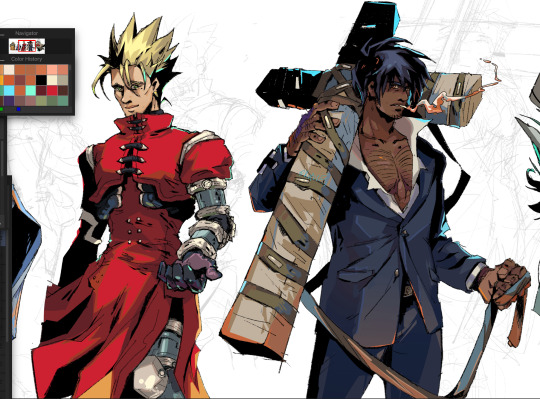
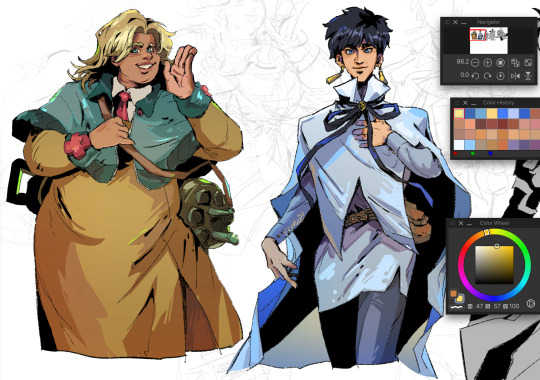

trigunned the hades or hadesed the trigun (id in alt)
#trigun#trigun maximum#nicholas d wolfwood#vash the stampede#meryl stryfe#milly thompson#millions knives#ruporas art#type of shit ive been on lately bc ive been playing an obsessive amount of hades 2 lmfao… ofc imstead of drawing fansrt for hades#i channel that energy into trigun?😭 SEE.. the thing is. i am ALWAYS thinking about a trigun game… like an action story game#it is rotating in my brain 24/7 and now after 7billion years i finally pick up a video game#and the inspiration sparked. obviously this is just a mere mimic of an existing media... but im thinking about the plot of max now#executed differently between mediums… webbing a new retelling of the original story as game mechanics allows you - thinking of the#new roles the characters would take. like wolfwood here is not Constantly by vash’s side but he will show up once a run to clear out an#encounter. shows up seldomly at home base to make gifting difficult... an existing companion and still journeys on his own. for more#relations options merylmilly will also have occasions where they separate so vash can speak to them individually - the gungho are not bosse#most of them get the roles of giving “boons” i think.. BUT ANYWAY thats me reimagining trigun into hades. now imagining trigun into an#ORIGINAL video game.... ough... ohhh....guhh... I WANT IT SO BAD!!!!!!!!#this was just a fun exercise... im thinking about doing more but i think i shouldactually draw some hades 2 fanart first
2K notes
·
View notes
Text
hey you. watching the game awards. wondering “why did the cast of alan wake 2 do a full on fucking musical number?”. go play/watch someone play alan wake 2 immediately. this is not a request this is an urgent command
#tga#the game awards#alan wake 2#this game takes advantage of the Video Game Medium in ways i’ve never seen before and#more people should know and appreciate it#and also the musical cutaways rule. but that’s secondary
1K notes
·
View notes
Text
i love how like nobody really talks about the possessions in ace attorney. spirit mediums and possession and lowkey magic just exists in ace attorney and nobody talks about it. there’s LOTS people make posts about that detail the craziest things abt ace attorney and nobody is like oh yah spirit mediums and possession is like a huge part of the game series btw
#everyone is just so accepting#including me whenever i talk about the plot to anyone#sometimes i hit a point where i have to explain the spirit medium stuff#and i’m like okay wait so spirit mediums r a real thing in the game#dw about it#ace attorney
1K notes
·
View notes
Text
||The cursed treasure hunt||
reserved au rp with @demon-blood-youths
"Anything yet?" Megumi blinks to hear this but he looks from his cell phone. He didn't know what was going on, giving the thought that something might have happened. Gojo was told Kisho still was on his on going mission to find the cursed items that came from that party. However, it leaves another wondering what was going on. He did have some help along the way so it was something.
Right now, Megumi was told by Gojo to check on him but he was not answering the text messages he sent a while ago. "I don't think so. I can try to call him and see if he can answer the phone instead. Or maybe something is effecting the signal."
"I guess that's possible but give it a shot." Yuji said. Megumi nods and goes to do that, seeing Kisho's number and hits speed dial and waits for him to find something.
"I'm sure they are fine you two..just call them and we will see their fine." Nobara said. Miko agrees hoping they were alright. She wanted to go with them but she was still on stand by to recover.
"S..same here..." she mutters seeing Megumi still waiting for Kisho to pick up.
#IC#silver roses#rp reply#the cursed treasure hunt#thesilverpeahenresidence#Curse Game Party#jujutsu kaisen au#yuji itadori#the cursed vessel/jujutsu sorcerer of the damned#megumi fushiguro#shadow jutusu sorcerer/chimera snake#nobara kugisaki#voodoo doll jututsu user/the cursed nail witch#gojo satoru#limitless cursed user/strongest jujutsu sorcerer#miko yotsuya#the girl that sees all/the bear badger exorcist#yuria niguredou#medium in training/cursed spirit gunner exorcist#chunibyo-x-sorcerer
913 notes
·
View notes
Note
are you secretly the CEO of solkat
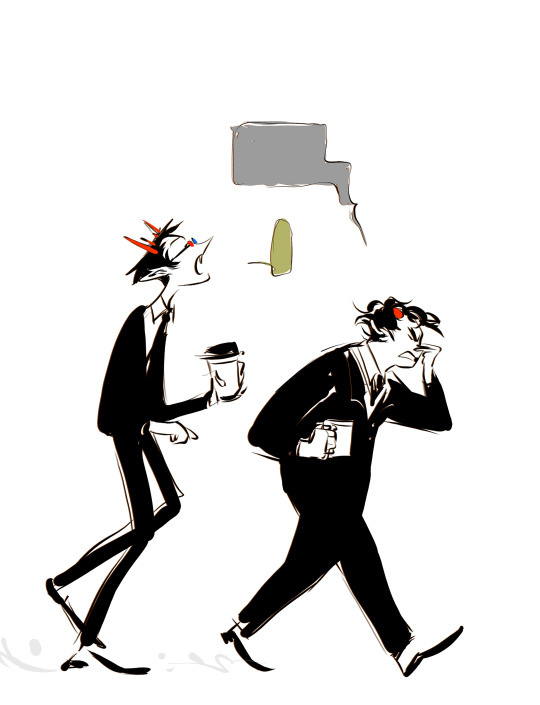
solkat r the ceos of me. actually
#am but a fresh minnow in this decade old aquarium i dont feel worthy of this title#as a chaser of the trail left by the established reigning fish i say‚#the yaoi game of the og slkts are insane!11 i cannot hope to come close#also i think solkat might b more than tumblr.?#there are bubbles of slkts living in other ecosystems that we tumblrinas are not privy to for sure :o#ask#anon#homestuck#2024#sollux captor#karkat vantas#solkat#vioart#ok as candidate-in-training my slkt take of the day is that they have a startup tgt ☝️🤓#worst bosses ever btw these two grind so fucking hard#if u dont keep up w them whoopee youre booted off for killing the team spirit so dead even the mediums wont absolve u#their company culture bonds over shitting on ex-employees :(
1K notes
·
View notes
Text





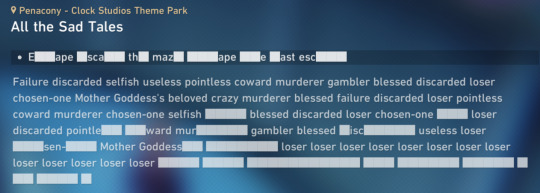

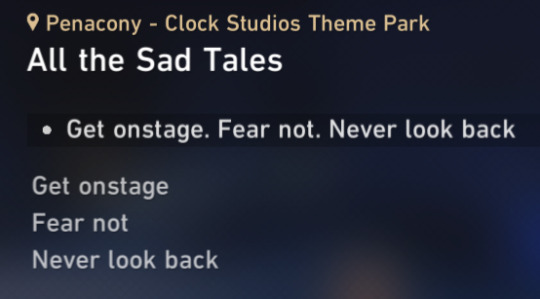
All of the quest menu descriptions for Aventurine's quest "All the Sad Tales".
(... And the one from "A Walk Among the Tombstones.)

#hsr spoilers#honkai star rail spoilers#hsr#honkai star rail#hsr aventurine#penacony spoilers#i really don't look at quest menu text often#but i'm glad i did this time around#i think that's all of them but i could have missed one or two#the text for the next step sometimes changes while keeping the same description so i only captured it once each time#this is was really funky but also goddamn aventurine just had a horrible time the whole patch#delightful for me personally#who loves it when characters suffer#mihoyo pulled 0 punches#i hope i used enough spoiler tags cause that's big fat spoilers right here but it's one of the things i liked the most about the new quest#i love it when games have fun with their medium#ray's records
370 notes
·
View notes
Text
can we stop putting motion blur in video games forever please
it never looks good, and all it ever really accomplishes is needlessly obfuscating the game state.
like who the fuck says "oh gee this game is great, but i wish every time i moved the camera it would become 10 times fucking harder to tell what the hell is even going on"
#juney.txt#''oh but it looks more cinematic'' if you want to watch a movie go watch a fucking movie#video games are not cinema. cinema is not the highest form of art to which all other artforms should aspire.#play to the strengths of your own medium rather than trying and failing to look like a completely different one
282 notes
·
View notes
Text
headcanon that Neil's hair is brownish auburn in the winter but in the warmer months when he's outside a lot, it lightens to a more coppery reddish color
#yeah im reconciling the hair color debate once and for all what about it#why pick between auburn and ginger when we can have both :)#also covering my ass bc i am constantly changing the shade of his hair in my art lmao#aftg#all for the game#the foxhole court#neil josten#loosely inspired by my own hair btw which goes from medium brown in the winter to coppery blonde in the summer months
243 notes
·
View notes
Text
Game Medium - Cult of the Lamb: Designing an Emergent Enviornment
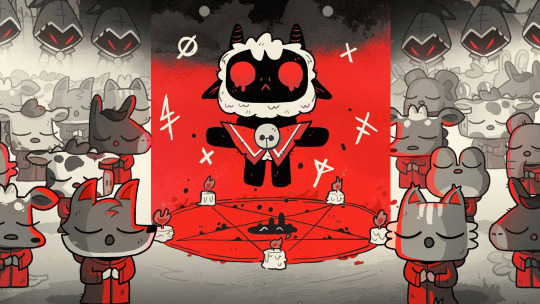
Story Details of Cult of The Lamb, potential spoilers
When setting up dynamics with your mechanics and intended tactics, what happens if those dynamics were morally dubious? How do you get a good chunk of players to do questionable actions by default? I’m not speaking of the “genocide endings” of many games like Undertale or Bioshock in which the players are intentionally trying to be the worst version of their character to see what the game offers; I am talking about producing an environment in which the behaviors that would lead to a genocide ending are actively encouraged. Behaviors likes drugging everyone in your community so that they don’t notice you harvesting corpses for meat, murdering dissenting neighbors behind everyone’s back so they could stop spreading “bad” ideas, and sacrificing live people to an eldritch god for your own benefit. This is what you do in Cult of the Lamb.
Cult of the Lamb, the latest indie game by Australian indie studio Massive Monster, is a game where you play as a lamb who wants to take revenge on the old faith that tried to kill them by, with the help of an imprisoned god, raising a cult and using that cult to slowly get power for their vengeful crusades. The game mashes dungeon crawling roguelikes like Binding of Isaac and Hades, the crusades that you do to kill the bishops of the old faith, with the management sim genre seen in Animal Crossing or Spiritfarer, the cult management. While Cult of the Lamb is pretty stock standard in the individual roguelike and management sim components, it has proven to be much more than the sum of its parts, reaching more than a million players worldwide after 9 days of its release and rocking a 9 out of 10 score on Steam as of August 27th, 2022. It’s a testament to how brilliant the game design is that it could have such a high reception despite being extraordinarily buggy with multiple softlock bugs on release (especially the switch version, which was the one I had).
What makes Cult of the Lamb such a fascinating game for me is how it creates an environment that promotes morally dubious behavior to your own followers, a genius subversion of what’s typically expected from the management sim genre. The game doesn’t actively promote eradicating your followers immediately, you need at least 20 living ones to beat the game, but it adopts a brutal utilitarian standpoint that views your followers as nothing more than pawns. As fellow rat Scuffle’s points out, the game “feels like a social experiment to see how awful you can be if it’s dressed up cute enough”. However, I think it takes a little more than an artstyle to get people to do heinous things in your games. Before I explain further, we must talk about emergent storytelling.
Emergent storytelling is storytelling that emerges from a player’s interactions with the game organically. These are stories that come from simply placing the character in an environment they can interact with and seeing what happens. These are the cool stories you tell to your friends, whether it was the funny baron steal in League of Legends, how you single handedly made a huge comeback in a fighting game, or just stories about what you did to your characters in Sims. While there are games that can be described as pure emergent storytelling like Sims, Animal Crossing, and Minecraft, all games that allow you to substantially interact with your environment and other entities in meaningful ways have some form of emergent storytelling. An RPG like Fire Emblem, usually has a very linear story with each battle having a fixed before cutscene and after cutscene, but how you get from point A to point B is entirely emergent. You could easily just stomp the entire enemy with over-leveled units, come up with a flawless strategy with no deaths, or have a rough battle that leads to many casualties.
One of the biggest misconceptions that I was guilty of was thinking that you can’t really control emergent storytelling, meaning that you can’t do something meaningful with it. In the context of emergent storytelling, you are simply the designer of a playground for the players to play on. You could guide them to do certain things, but ultimately it is up to the player on how they play the game. It’s generally considered good practice to allow MORE player freedom, not less. While some of that is true, Cult of the Lamb taught me that the emergent playground you make can also have its own politics, carefully constructed by the designer. In the context of Cult of the Lamb, the game paints an extremely satirical, cynical view of religion, painting the followers as dumb little sheep that sometimes have thoughts about eating poop and would sometimes willingly ask the player to sacrifice them for their gain. The way you get followers in the first place is by saving them from a harsh world where other cults sacrifice them or turn them into monsters, yet despite this generous offering of a stable home, the game motivates you to see them as merely pawns to be manipulated and possibly sacrificed for your gain.
To create an emergent environment with its own bias, you have to do 3 things:
Establishing the main story goal and side quest goals for the game
Designing mechanics that lead to potentially desired dynamics
Setting up the story context around outcomes of the dynamics through writing and art
To explore this further, let’s look at how Cult of the Lamb utilizes these 3 principles to create its play environment.

Establishing the goals of the game
In general, the goal of the titular lamb character is to simply get revenge on the bishops of the old faith for executing them because of a prophecy that a lamb would release the devil. After the lamb was executed, they were sent down to the devil which revived them and allowed them to enact their revenge, but in turn, they must work on releasing him, the devil, through creating a faithful cult in his image. To release the devil, the lamb must kill all 4 of the old faith bishops through the roguelike dungeons. The cult is mainly used to unlock new dungeons and bless you with powers similar to the progression of a roguelite.
In this way, the management of the cult is always secondary to the main goal of killing all of the old bishops. The game motivates the player within the text to see the cult as merely a means to an end, but how effective are they as a means? To make progress within the game, the cult must have at least 20 members. Additionally, to get those incremental roguelite buffs, those followers just have to attend sermons that are available once a day within the game, or be sacrificed for faster progress gain. In short, the only goal that is important is maintaining the number of followers you have, but how do you maintain followers?

Designing Mechanics Leading to Desired Dynamics
In order to create the emergent environment, one needs to design mechanics that would generally lead to optimal dynamics. For example, if I make a zoning mage character, I wouldn’t want the desired strategy of that mage character to be attacking in melee range. Similarly, I wouldn’t want a rush down character to have the optimal META dynamic to be running away from enemies and stalling out the game using their faster speed (sadly this is Sonic from smash). These are basic game designer M/D/A fundamentals, but they’re important because they force the player to adopt certain strategies over others through the usage of motivators and consequences in regards to the main goal of the game. How does certain actions move the player towards the goal? How does an action block it?
Using Cult of the Lamb as an example, the player is trying to maintain the follower count to gain power ups and progress. To keep followers, players need to keep track of their physical health (hunger, exhaustion, sickness) and their faith. Physical health tends to be slower and easier to control for, merely requiring the usual standard fare of sims management, feeding your followers, cleaning up after them, tending to those that are sick, and making sure they maintain an active farm so that you won’t run out of food. If one dies from old age or any other unknown reason, you could always go to the dungeons to find more followers or buy them from the shopkeeper, further illustrating how they are replaceable. The cost of a dead follower, as long as you have money or can find someone in the dungeon, is very minimal.
However, players will have more difficulty maintaining follower faith. From my playthroughs, it's always the fastest to drain after crusades and the ones that can directly cause dissenters who could lower the faith of other nearby people and eventually leave the cult. What makes this immensely interesting is that there are numerous ways to increase faith for followers. Some are pretty obvious like completing follower quests, doing sermons, and giving gifts. That being said, certain follower quests can lead to very dubious outcomes like wanting to eat poop or others to eat poop for a totally harmless prank. This creates a direct conflict with the first aspect of maintaining followers. Another example of this conflict are grass meals. If you feed someone grass meals, followers will lose faith because they taste bad unless you have a certain doctrine.
Speaking of doctrines, throughout the game you could declare doctrines that allow you to do certain rituals like marriage or trial by combat, change the behavior of your cult by giving them certain traits, or give yourself the permission to do certain actions like bribing or killing. Maybe you could allow them to eat grass without losing faith, or have a fasting ritual where they don’t lose hunger, or give yourself the ability to bribe people to increase their loyalty. What makes this interesting is that sometimes the more dubious doctrines are just objectively better. Take the one about drugs. In Cult of the Lamb, there is a ritual in which you can brainwash all of your followers on drugs. You can choose between these 2 doctrines:
Substances Encouraged: All cult members will gain the Substances Encouraged Trait. Gain 20 Faith when Brainwashing Ritual is performed.
Belief in Prohibition Trait: All cult members will gain the Prohibitionist Trait. Work speed and devotion generation increased by 10% but 50% chance of followers becoming sick after the Brainwashing Ritual.
If you choose the latter, you practically cut yourself off from doing the brainwashing ritual which tends to be one of the better ways of maintaining high faith while on crusades or doing other dubious actions that would lead to faith going down. The former actively has no downsides to it, making the brainwashing ritual double as a faith gaining tool as well as a faith maintenance tool. The game makes no consideration of the consequences on any of your followers’ wellbeing in the form of dialogue or downgrades in faith or even physical health. In fact, your followers will do even better in missions if they’re drugged. After all, they’re merely pawns for your vengeful quest, why should you care.
As a result of these types of doctrine choices and certain questlines, players are given a wider space to allow for manipulation. Less consequences and more benefits are placed with actions concerning bribery, drugs, and intimidation. In some of these cases, like the brainwashing ritual, the only real consequence concerns the player’s moral compass. This ultimately leads to an environment where these behaviors are encouraged. You could still do moral things within the game with your doctrine choices and actions, but you won’t be punished if you do less moral ones. In some cases, you’ll be rewarded. As the game states when introducing rituals, the goal is to manipulate your cult, not care for them. Through this, the game equates managing the loyalty and health of a religion or cult partially as an act of deception and control.
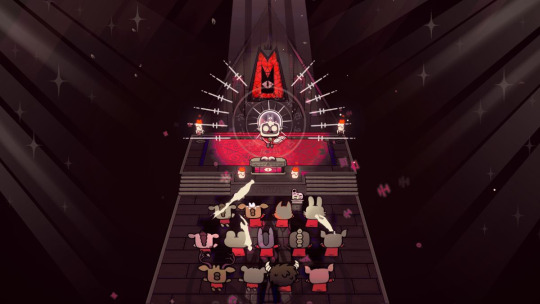
Writing Narrative Context
This type of cruelty is also normalized by the writing. The world that Cult of the Lamb paints is a world dominated by religious fanatics willing to sacrifice innocents for favors. The way you get followers is simply by rescuing them from being sacrificed or just helping them get out of the dungeon. The old bishops were known to torture their followers to induce loyalty. Kallamar, the 3rd bishop, was known to poison their followers to make sure he could stay in power. Even the god that you serve advises to see your own followers as pawns to manipulate. On the side of the followers, the game sends a message about how cruel conditions can lead to followers and crowds desperate to find hope in anything, even if it’s just a marginally less cruel cult than the one they once joined. More importantly, this story premise is immensely flexible for an interactive game, justifying literally anything you’ll do within it.
If you are immensely cruel to your followers and doing the minimum nice things, it’s a narrative about how this cruelty is a never ending cycle of zealous followers trying to find hope in anything that’s slightly better and leaders abusing that desperation to get away with anything they want as long as they keep the faith and happiness high. Who cares if I kill a dissenter if I can just declare a vacation from work and make everyone happy again. If you are the opposite and treat your followers nicely, you become a hope of light in a world that frankly doesn’t have any, and there are many emergent story choices in between those that can make the reading of your playthrough interesting.
Writing in itself can’t change a game functionally. Compared to the other 2 points mentioned before, it can’t really influence the strategies that the player will use. This is ultimately the limit of writing in a game, especially outside of cutscenes. That being said, writing is great for creating context for the strategies the player will use. This interaction between player actions/dynamics and the author’s writing can create special emergent stories, whether it’s a final hail mary in a boss, drugging followers to make sure faith won’t go down, or allowing a follower to eat poop because they really want to and their faith would go up if you did feed him, being a “slave to your followers”, something that your god even warns you about.
Ultimately, what Cult of the Lamb does isn’t anything new. A lot of their gameplay and their tactics are very standard. Everything that I’ve mentioned is just what a game designer and narrative designer do normally. Cult of the Lamb just simply used those fundamentals to make a very compelling game with satirical commentary on hope, religion, and cults. While the individual parts of cult of the lamb aren’t anything to be impressed at, it is these design principles that bring it all together.
0 notes
Text
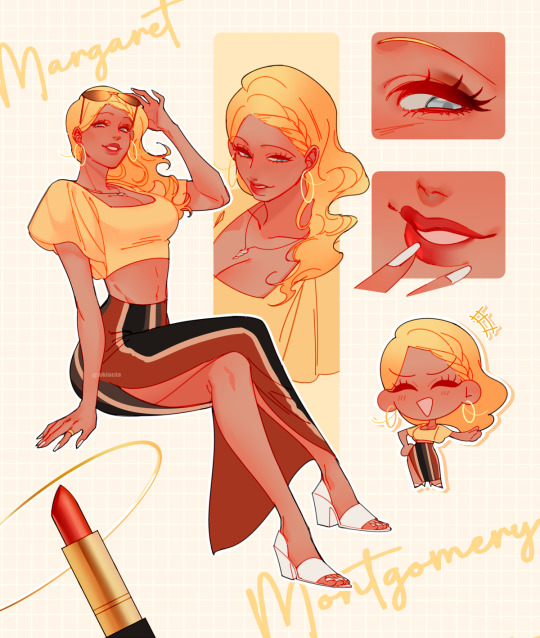
maggie ref! remastering this sketch from july 2023
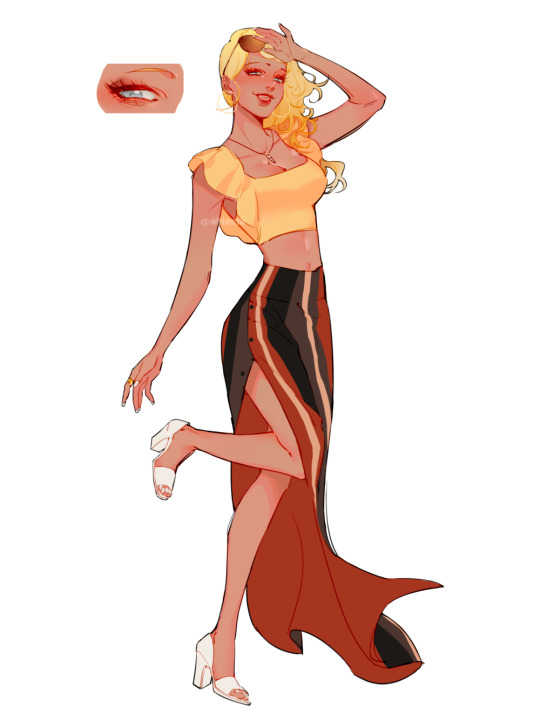
the vanity angles don't make it a more useful reference but i enjoyed drawing it 🤣
#akia art#olba#olba mc#maggie's step 1/3 designs haven't changed much from when i initially played the game in 2021#but i didn't settle on steps 2/4 until i revisited it last year 🤣#i can't tell if i've improved since or if the differences are attributed to time spent and drawing mediums used LOL 👴#my tablet art takes a more delicate look that i still prefer tbh#anyway for my spirit's sake i'll say i got better here and there lmao
158 notes
·
View notes
Text



kittyfies them i guess,,,,
#ocarina of time#oot#impa#zelda#sheik#ganondorf#i think i decided zelda/sheik is a cornish rex but im still not sure about impa & ganon’s breeds#visually tho impa is built kind of like a bengal and i sort of hc her as having albinism so she has v little pigmentation regardless#ganon is like. a medium haired maine coon or similar large breed. with tortoiseshell coloration that is incredibly rare in male cats#the fur pattern i gave him is a little bit more organized than in actual tortoiseshells i think but sshhhhh#and then sheik’s eye color changes to red and her fur pattern also slightly changes#to vaguely resemble sheik’s emo hairstyle covering one eye in the game :3#anyway. yeah
405 notes
·
View notes
Text
I think what makes TLOU show both enjoyable for the new and old fans is that they've kept the main story beats the same but the ways we actually get to these points are extremely different and take full advantage of the transition between mediums. We get a lot more time with the actual characters rather than on exploration and I'm really digging the pre-outbreak exposition we're getting before every episode
#i think both mediums have their upsides but at least with the tv show theyre doing a good job so far at acknowledging#that this isnt a video game and they dont have to spend so much time on parts of the story that were more reliant on player exploration#tlou#the last of us#tlou spoilers#sorry for tlou post dumping getting all my thoughts out now#laurel.txt
2K notes
·
View notes
Text
Hey Discworld fans and followers, @modiphius has secured a license to make games based on Sir Terry’s Discworld! Super stocked I also sent them my art 🤷♂️ 🤞
But anyway, they seem really genuine and excited about working on this project and have a survey for Discworld fans so they can understand why people love the books as best as possible which I think is a beautiful way to make a game.
Heres the survey for anyone interested
https://docs.google.com/forms/d/e/1FAIpQLScotOFrIAHQwG-Af9kIq_kLbX0W7kqxBt67nR2uzUWkRolSqA/viewform
#discworld#sir terry pratchett#terry pratchett#discworld fan#discworld game#gnu terry pratchett#not as big as medium sized jock but bigger than wee sized jock jock#sam vimes#guards guards#wee free men#moist von lipwig#lord vetinari#tiffany aching#discworld tabletop game
267 notes
·
View notes
Text
JOHNNY VOICE LINE TRANSCRIPT 🥩

I wrote these out a long time ago but never posted them anywhere! Based on [x].
>Nancy's voicelines<
Notes:
• I could've copied the game subtitles, but I didn't 'cause they suck.
• I haven't played enough Johnny to know where some of these lines start and end. Please let me know if I've made any mistakes in that regard!
• I was gonna include tone indicators, but tone is subjective. No one wants me to mark the Feed Grandpa voice lines as "Flirty."
Thanks!
VOICELINES
Encounter Start
Now look at this! Somebody's ready to fight!
This is gonna end... Very badly for you.
Yeah-ha-ha! Oh, that's it! Hit me...
Imma gut every single one of y'all! [Inhales, laughs under breath] Come on... Come on!
Exit interaction
Nobody leaves until I say so!
Ain't nobody leavin' just yet!
Got it.
Nobody's leavin' alive! Y'all not fast enough! ... Good try, though.
Feed Grandpa
Get your fill, old man.
It always tastes best when it's fresh, don't it?
Here you go, old man.
You're lookin' better already... Now help us!
Oh, you're thirsty today.
Victim found
HA HA! It's playtime!
Heh heh, it's playtime...
Hahahaha, I always find 'em!
You should know better than that! ... Come on out, now.
Hey there! [Laughs]
Well! Look who we got here! [Laughs]
Hit victim
Oh! Now I got ya!
Yeah! Take it! Take it!
It's better if you die right quick! Trust me!
This would be simpler if you would sit still!
Yeah! You gonna be leakin' after that hit.
Idle
Nobody escapes me.
How the hell did those kids find us? [Sighs] I should've been more careful.
If Grandpa was able, this would be over by now... I better go feed him.
Damn it, Johnny... Get your head straight! Come on, now!
I gotta fix this... Now!
Cook seen
I'd watch that tongue of yours, old man... It might go missin' one day.
I thought you knew how to run this household... THIS is a mess!
Damn it, old man! Put those ears of yours to use already!
Where are they?! How the hell did they get loose?! I can't fix this by myself, old man.
Stop barkin' orders at me! You ain't gonna like the results.
Hitchhiker seen
Surround the property with some of those traps already! This is getting outta hand fast!
You're one shifty little sumbitch... I'll give you that. [Laughs]
How you make those weird ass traps of yours, anyway?
Would you. Settle. The Hell. Down already. You're scattering all over the dang place. We gotta focus!
Grandpa is gonna tan our hides if we let them get away. Spread out!
Leatherface seen
That's it, boy... Go kill someone now.
Go on, put that saw to use, big boy! What're you waitin' on?
If I were you, I'd go and check out Grandpa. We're gonna need his help!
Let's go now, boy! Grandpa ain't gonna be too pleased if you let them escape.
Just get outta my way, boy... I'll show you how real killin's done.
Sissy seen
Are you gonna help me out, or just stand there lookin' pretty?
If it ain't askin' too much, before you go and run off again, would you mind helpin' me out?
Before you go runnin' off with those back-house hippies again... Can you PLEASE find these damn kids?!
Sissy, what the hell're you waitin' on? Get to it!
Sissy... Are you even listenin' to me? What's goin' on in that head of yours?! Damn!
Lose enemy first
Aww, you leavin' so soon?
It's alright, big boy's gonna be wearing your face soon enough... After I'm done with you, that is. [Laughs]
You know... I was actually kinda fond of that girl, I-I didn't really wanna hurt 'er... But, as they say... Family first, y'know?
You ever watch someone die? Oh... You ain't never quite the same after that, lemme tell ya.
Ohohoh, you can run all you want... It ain't gonna matter much longer.
Lose enemy sub
[Scoffs] You're all gurgle and no guts! I thought you were tougher than that!
I'm gonna find you... I will! I promise!
You wanna know how your friend died? I can show you!
L-Listen now! E-Everybody's time comes eventually!
The bad man's in me... And you gonna meet 'im real soon!
Lose enemy long
Your little friend put up a better fight than this... Come on... Make it interesting, will ya?!
They always try to hide... It's always the same game... [Laughs]
You folks don't know who you messin' with! Nobody ever gets away from me.
You're just delayin' the inevitable! YOU HEAR ME?
Come on out now, let's play.
I got plenty of space in the cold room for you.
Match start
It's time. [Chuckles] Seems they've got some fight in 'em after all.
I knew I should've handled this myself... I'll fix it.
That's what I get for taking it easy on them. Time for them to join that little friend of theirs.
See blood trail
Oh, this is gonna be easy.
Hey, you okay? You seem to have lost a bit of blood!
Now... let's see where you scurried off to.
You know... Bleedin' like that ain't gonna help your cause!
Don't bleed out on me yet! I need you awake!
See enemy first
Don't worry. I like it when they run.
Look, you're gonna want this to end fast. Trust me on that.
Well, don't run! I just wanna see how it feels.
There you are! [Chuckles] You kinda remind me of your little friend.
See enemy sub
This is pointless, you know. Quit stallin'.
Don't worry... I'll find ya.
[Growls] I'm gonna see your insides before this night's through!
Oh, you ain't gettin' away! I'm keepin' you.
Come on back, now.
Got something I wanna show you! [Laugh]
See family member
Well! Look who decided to lend a hand!
Check the doors and generator. We can't let them leave. You hear me?
Y'all need to start pullin' your weight around here. This is gettin' old!
Grandpa's gonna be in a fit if we let them escape. Start searchin'!
Would y'all... Help me already. PLEASE!
See trapped victim
We gotcha! [Laughs]
You ready to meet the bad man?
You got one!
Looks like you might be hurtin'. Might wanna be watchin' where you're steppin'.
[Laughs]
See victim escape
Maybe I can still catch 'em. Yeah, down by the tracks.
Damn... They're free... For now.
This isn't gonna be good.
Damn it, Johnny! [Scoffs] ... The old man's gonna be riled up now.
Use ability blocked
Ain't no tracks here...
Nah... got nothin'.
Better wait a minute.
Not quite yet ... [Inhales] Almost ready.
Use ability
Time to play. Now... Where did you go?
I'll find ya. Don't you worry about that.
Go ahead and hide... It ain't gonna matter.
Where'd y'all run off to?
Use ability success
[Hums] ... There you are.
They always leave a trail. Always so careless. [Chuckles, inhales] ... This is too easy.
I'm on your tail now!
Execution
You're gonna look real nice... Next to that friend of yours!
That's it... Die for me!
This... Is only gonna hurt... For a minute!
You should've never came here lookin' for that girl!
You ain't gettin' away! I'm keepin' you!
[Last edited March 2024]
#It's about making things accessible okay? Everyone benefits from having things available to them in more than one format/medium.#johnny slaughter#tcm game#txchainsawgame#texas chainsaw massacre#tcm#johnny sawyer#transcript#subjectspeaks#greedy#queue#I also wrote out Sissy and Nancys but thats for another time
143 notes
·
View notes